Detailed Case Analysis: Shafron v ASIC (2012) HCA 18
VerifiedAdded on 2020/04/15
|8
|2696
|194
Case Study
AI Summary
This case study analyzes the landmark case of Peter James Shafron v Australian Securities and Investments Commission (ASIC) (2012), which addressed the responsibilities and duties of company officers under the Corporations Act 2001 (Cth). The case stemmed from Shafron's role as company secretary and general counsel for James Hardie Industries Limited (JL) and focused on allegations of breaches of duty concerning ASX disclosure and actuarial issues. The analysis follows an IRAC (Issue, Rule, Application, Conclusion) structure, examining the factual background, the legal issues at stake, and the relevant provisions of the Corporations Act, particularly Part 2D.1. The case highlights the importance of directors and officers fulfilling their obligations, with the High Court upholding the Court of Appeal's decision, finding that Shafron had breached his duties of care and diligence. The judgment emphasizes the need for officers to provide accurate information and advice, and to act in the best interests of the company. The analysis also covers Shafron's arguments and the court's reasoning, providing a comprehensive overview of the case's implications for corporate governance in Australia.
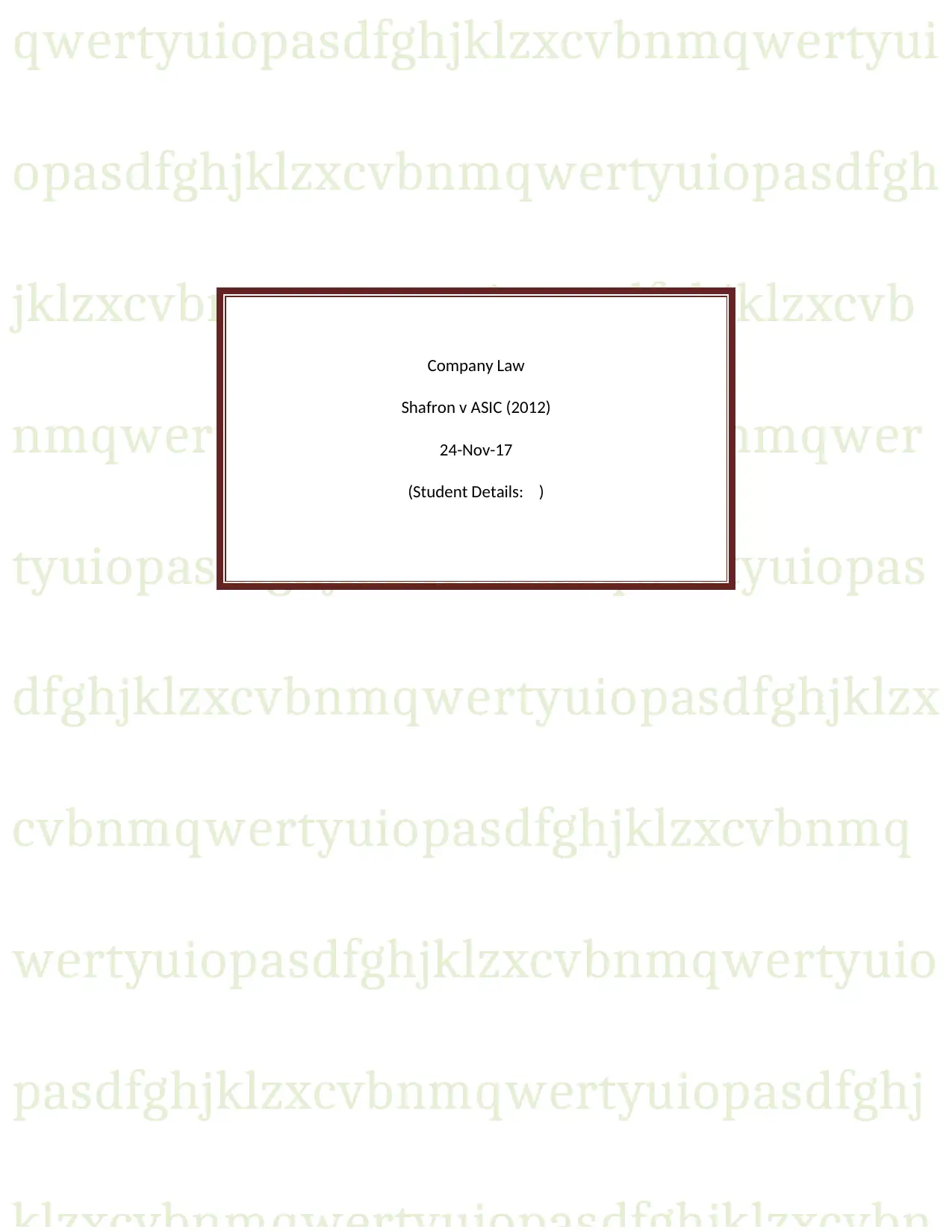
qwertyuiopasdfghjklzxcvbnmqwertyui
opasdfghjklzxcvbnmqwertyuiopasdfgh
jklzxcvbnmqwertyuiopasdfghjklzxcvb
nmqwertyuiopasdfghjklzxcvbnmqwer
tyuiopasdfghjklzxcvbnmqwertyuiopas
dfghjklzxcvbnmqwertyuiopasdfghjklzx
cvbnmqwertyuiopasdfghjklzxcvbnmq
wertyuiopasdfghjklzxcvbnmqwertyuio
pasdfghjklzxcvbnmqwertyuiopasdfghj
Company Law
Shafron v ASIC (2012)
24-Nov-17
(Student Details: )
opasdfghjklzxcvbnmqwertyuiopasdfgh
jklzxcvbnmqwertyuiopasdfghjklzxcvb
nmqwertyuiopasdfghjklzxcvbnmqwer
tyuiopasdfghjklzxcvbnmqwertyuiopas
dfghjklzxcvbnmqwertyuiopasdfghjklzx
cvbnmqwertyuiopasdfghjklzxcvbnmq
wertyuiopasdfghjklzxcvbnmqwertyuio
pasdfghjklzxcvbnmqwertyuiopasdfghj
Company Law
Shafron v ASIC (2012)
24-Nov-17
(Student Details: )
Paraphrase This Document
Need a fresh take? Get an instant paraphrase of this document with our AI Paraphraser
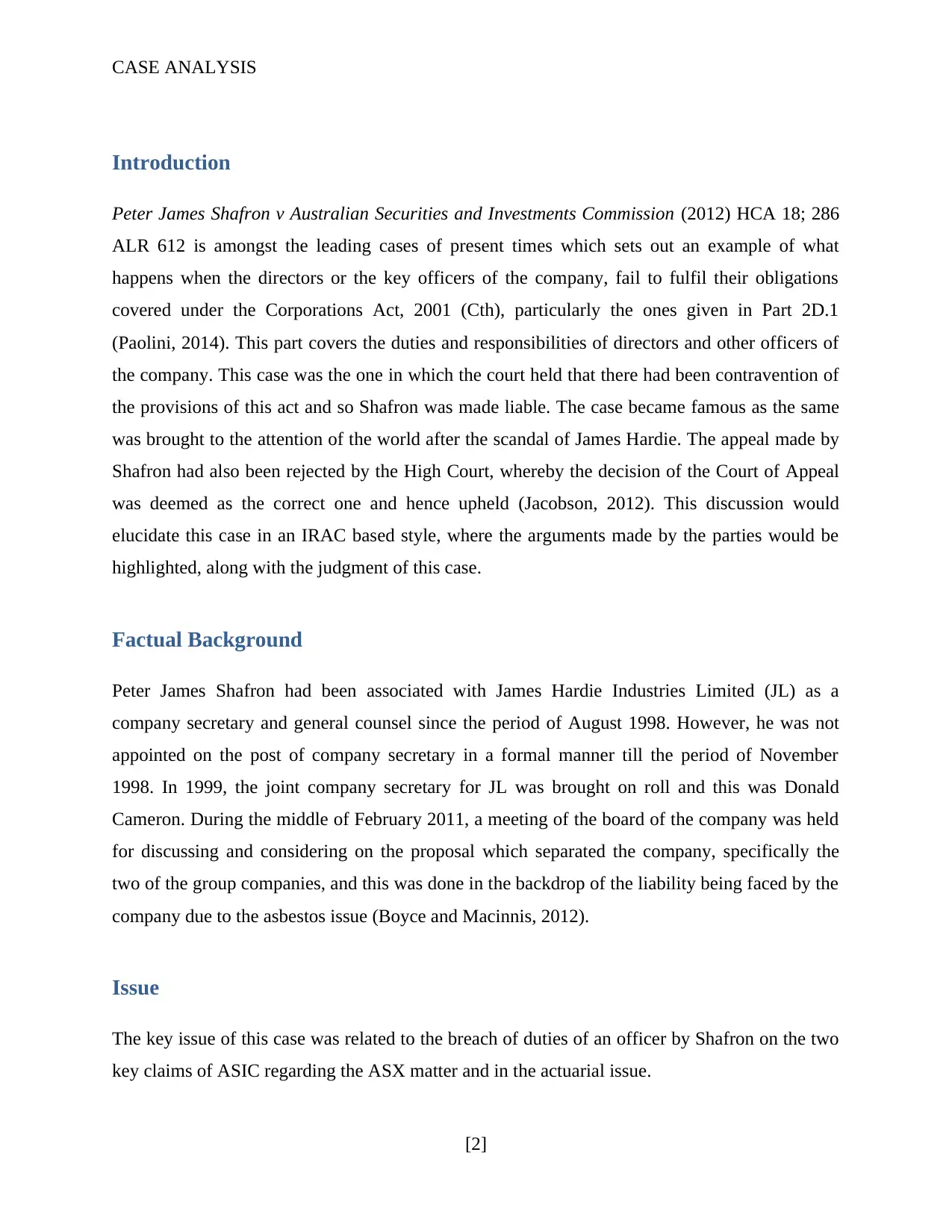
CASE ANALYSIS
Introduction
Peter James Shafron v Australian Securities and Investments Commission (2012) HCA 18; 286
ALR 612 is amongst the leading cases of present times which sets out an example of what
happens when the directors or the key officers of the company, fail to fulfil their obligations
covered under the Corporations Act, 2001 (Cth), particularly the ones given in Part 2D.1
(Paolini, 2014). This part covers the duties and responsibilities of directors and other officers of
the company. This case was the one in which the court held that there had been contravention of
the provisions of this act and so Shafron was made liable. The case became famous as the same
was brought to the attention of the world after the scandal of James Hardie. The appeal made by
Shafron had also been rejected by the High Court, whereby the decision of the Court of Appeal
was deemed as the correct one and hence upheld (Jacobson, 2012). This discussion would
elucidate this case in an IRAC based style, where the arguments made by the parties would be
highlighted, along with the judgment of this case.
Factual Background
Peter James Shafron had been associated with James Hardie Industries Limited (JL) as a
company secretary and general counsel since the period of August 1998. However, he was not
appointed on the post of company secretary in a formal manner till the period of November
1998. In 1999, the joint company secretary for JL was brought on roll and this was Donald
Cameron. During the middle of February 2011, a meeting of the board of the company was held
for discussing and considering on the proposal which separated the company, specifically the
two of the group companies, and this was done in the backdrop of the liability being faced by the
company due to the asbestos issue (Boyce and Macinnis, 2012).
Issue
The key issue of this case was related to the breach of duties of an officer by Shafron on the two
key claims of ASIC regarding the ASX matter and in the actuarial issue.
[2]
Introduction
Peter James Shafron v Australian Securities and Investments Commission (2012) HCA 18; 286
ALR 612 is amongst the leading cases of present times which sets out an example of what
happens when the directors or the key officers of the company, fail to fulfil their obligations
covered under the Corporations Act, 2001 (Cth), particularly the ones given in Part 2D.1
(Paolini, 2014). This part covers the duties and responsibilities of directors and other officers of
the company. This case was the one in which the court held that there had been contravention of
the provisions of this act and so Shafron was made liable. The case became famous as the same
was brought to the attention of the world after the scandal of James Hardie. The appeal made by
Shafron had also been rejected by the High Court, whereby the decision of the Court of Appeal
was deemed as the correct one and hence upheld (Jacobson, 2012). This discussion would
elucidate this case in an IRAC based style, where the arguments made by the parties would be
highlighted, along with the judgment of this case.
Factual Background
Peter James Shafron had been associated with James Hardie Industries Limited (JL) as a
company secretary and general counsel since the period of August 1998. However, he was not
appointed on the post of company secretary in a formal manner till the period of November
1998. In 1999, the joint company secretary for JL was brought on roll and this was Donald
Cameron. During the middle of February 2011, a meeting of the board of the company was held
for discussing and considering on the proposal which separated the company, specifically the
two of the group companies, and this was done in the backdrop of the liability being faced by the
company due to the asbestos issue (Boyce and Macinnis, 2012).
Issue
The key issue of this case was related to the breach of duties of an officer by Shafron on the two
key claims of ASIC regarding the ASX matter and in the actuarial issue.
[2]
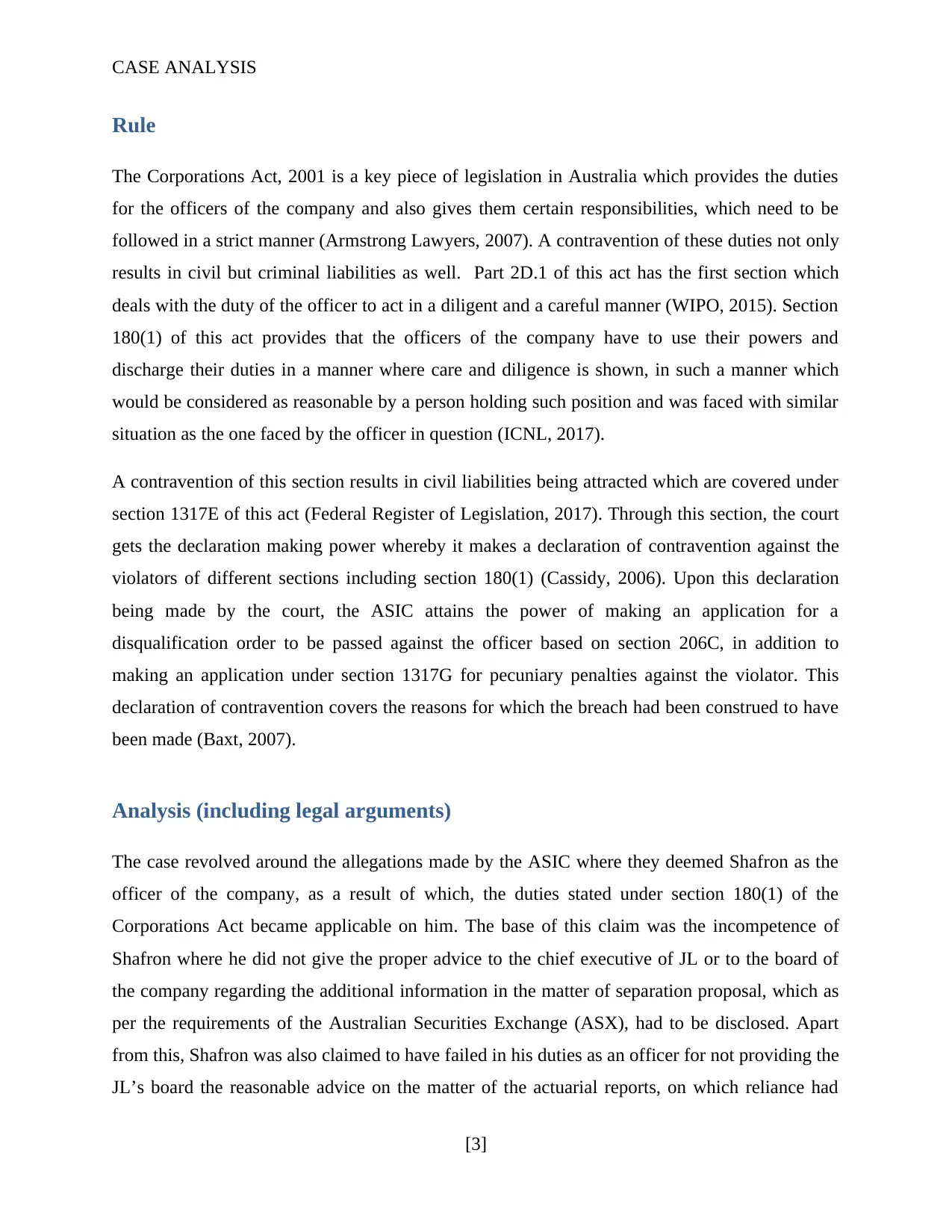
CASE ANALYSIS
Rule
The Corporations Act, 2001 is a key piece of legislation in Australia which provides the duties
for the officers of the company and also gives them certain responsibilities, which need to be
followed in a strict manner (Armstrong Lawyers, 2007). A contravention of these duties not only
results in civil but criminal liabilities as well. Part 2D.1 of this act has the first section which
deals with the duty of the officer to act in a diligent and a careful manner (WIPO, 2015). Section
180(1) of this act provides that the officers of the company have to use their powers and
discharge their duties in a manner where care and diligence is shown, in such a manner which
would be considered as reasonable by a person holding such position and was faced with similar
situation as the one faced by the officer in question (ICNL, 2017).
A contravention of this section results in civil liabilities being attracted which are covered under
section 1317E of this act (Federal Register of Legislation, 2017). Through this section, the court
gets the declaration making power whereby it makes a declaration of contravention against the
violators of different sections including section 180(1) (Cassidy, 2006). Upon this declaration
being made by the court, the ASIC attains the power of making an application for a
disqualification order to be passed against the officer based on section 206C, in addition to
making an application under section 1317G for pecuniary penalties against the violator. This
declaration of contravention covers the reasons for which the breach had been construed to have
been made (Baxt, 2007).
Analysis (including legal arguments)
The case revolved around the allegations made by the ASIC where they deemed Shafron as the
officer of the company, as a result of which, the duties stated under section 180(1) of the
Corporations Act became applicable on him. The base of this claim was the incompetence of
Shafron where he did not give the proper advice to the chief executive of JL or to the board of
the company regarding the additional information in the matter of separation proposal, which as
per the requirements of the Australian Securities Exchange (ASX), had to be disclosed. Apart
from this, Shafron was also claimed to have failed in his duties as an officer for not providing the
JL’s board the reasonable advice on the matter of the actuarial reports, on which reliance had
[3]
Rule
The Corporations Act, 2001 is a key piece of legislation in Australia which provides the duties
for the officers of the company and also gives them certain responsibilities, which need to be
followed in a strict manner (Armstrong Lawyers, 2007). A contravention of these duties not only
results in civil but criminal liabilities as well. Part 2D.1 of this act has the first section which
deals with the duty of the officer to act in a diligent and a careful manner (WIPO, 2015). Section
180(1) of this act provides that the officers of the company have to use their powers and
discharge their duties in a manner where care and diligence is shown, in such a manner which
would be considered as reasonable by a person holding such position and was faced with similar
situation as the one faced by the officer in question (ICNL, 2017).
A contravention of this section results in civil liabilities being attracted which are covered under
section 1317E of this act (Federal Register of Legislation, 2017). Through this section, the court
gets the declaration making power whereby it makes a declaration of contravention against the
violators of different sections including section 180(1) (Cassidy, 2006). Upon this declaration
being made by the court, the ASIC attains the power of making an application for a
disqualification order to be passed against the officer based on section 206C, in addition to
making an application under section 1317G for pecuniary penalties against the violator. This
declaration of contravention covers the reasons for which the breach had been construed to have
been made (Baxt, 2007).
Analysis (including legal arguments)
The case revolved around the allegations made by the ASIC where they deemed Shafron as the
officer of the company, as a result of which, the duties stated under section 180(1) of the
Corporations Act became applicable on him. The base of this claim was the incompetence of
Shafron where he did not give the proper advice to the chief executive of JL or to the board of
the company regarding the additional information in the matter of separation proposal, which as
per the requirements of the Australian Securities Exchange (ASX), had to be disclosed. Apart
from this, Shafron was also claimed to have failed in his duties as an officer for not providing the
JL’s board the reasonable advice on the matter of the actuarial reports, on which reliance had
[3]
⊘ This is a preview!⊘
Do you want full access?
Subscribe today to unlock all pages.

Trusted by 1+ million students worldwide
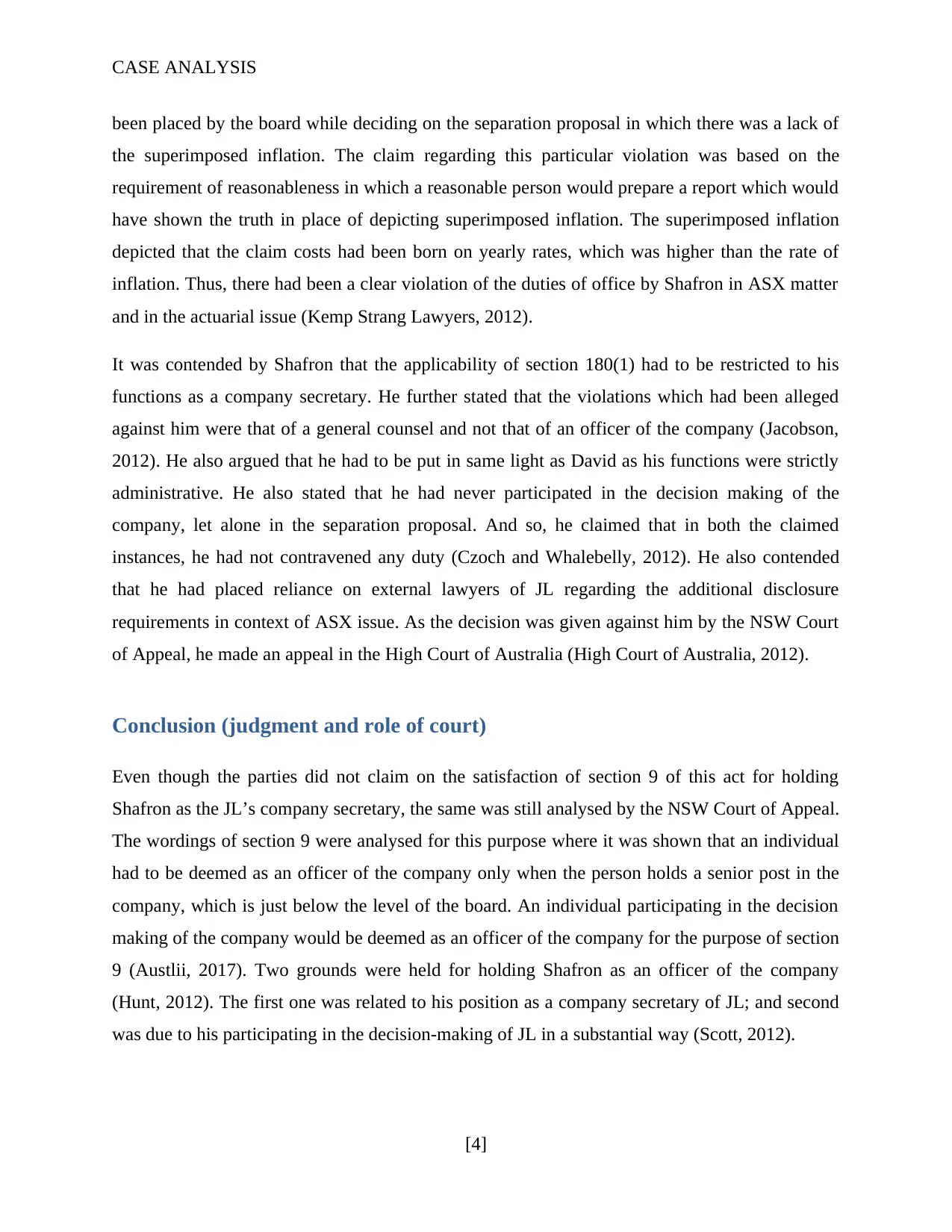
CASE ANALYSIS
been placed by the board while deciding on the separation proposal in which there was a lack of
the superimposed inflation. The claim regarding this particular violation was based on the
requirement of reasonableness in which a reasonable person would prepare a report which would
have shown the truth in place of depicting superimposed inflation. The superimposed inflation
depicted that the claim costs had been born on yearly rates, which was higher than the rate of
inflation. Thus, there had been a clear violation of the duties of office by Shafron in ASX matter
and in the actuarial issue (Kemp Strang Lawyers, 2012).
It was contended by Shafron that the applicability of section 180(1) had to be restricted to his
functions as a company secretary. He further stated that the violations which had been alleged
against him were that of a general counsel and not that of an officer of the company (Jacobson,
2012). He also argued that he had to be put in same light as David as his functions were strictly
administrative. He also stated that he had never participated in the decision making of the
company, let alone in the separation proposal. And so, he claimed that in both the claimed
instances, he had not contravened any duty (Czoch and Whalebelly, 2012). He also contended
that he had placed reliance on external lawyers of JL regarding the additional disclosure
requirements in context of ASX issue. As the decision was given against him by the NSW Court
of Appeal, he made an appeal in the High Court of Australia (High Court of Australia, 2012).
Conclusion (judgment and role of court)
Even though the parties did not claim on the satisfaction of section 9 of this act for holding
Shafron as the JL’s company secretary, the same was still analysed by the NSW Court of Appeal.
The wordings of section 9 were analysed for this purpose where it was shown that an individual
had to be deemed as an officer of the company only when the person holds a senior post in the
company, which is just below the level of the board. An individual participating in the decision
making of the company would be deemed as an officer of the company for the purpose of section
9 (Austlii, 2017). Two grounds were held for holding Shafron as an officer of the company
(Hunt, 2012). The first one was related to his position as a company secretary of JL; and second
was due to his participating in the decision-making of JL in a substantial way (Scott, 2012).
[4]
been placed by the board while deciding on the separation proposal in which there was a lack of
the superimposed inflation. The claim regarding this particular violation was based on the
requirement of reasonableness in which a reasonable person would prepare a report which would
have shown the truth in place of depicting superimposed inflation. The superimposed inflation
depicted that the claim costs had been born on yearly rates, which was higher than the rate of
inflation. Thus, there had been a clear violation of the duties of office by Shafron in ASX matter
and in the actuarial issue (Kemp Strang Lawyers, 2012).
It was contended by Shafron that the applicability of section 180(1) had to be restricted to his
functions as a company secretary. He further stated that the violations which had been alleged
against him were that of a general counsel and not that of an officer of the company (Jacobson,
2012). He also argued that he had to be put in same light as David as his functions were strictly
administrative. He also stated that he had never participated in the decision making of the
company, let alone in the separation proposal. And so, he claimed that in both the claimed
instances, he had not contravened any duty (Czoch and Whalebelly, 2012). He also contended
that he had placed reliance on external lawyers of JL regarding the additional disclosure
requirements in context of ASX issue. As the decision was given against him by the NSW Court
of Appeal, he made an appeal in the High Court of Australia (High Court of Australia, 2012).
Conclusion (judgment and role of court)
Even though the parties did not claim on the satisfaction of section 9 of this act for holding
Shafron as the JL’s company secretary, the same was still analysed by the NSW Court of Appeal.
The wordings of section 9 were analysed for this purpose where it was shown that an individual
had to be deemed as an officer of the company only when the person holds a senior post in the
company, which is just below the level of the board. An individual participating in the decision
making of the company would be deemed as an officer of the company for the purpose of section
9 (Austlii, 2017). Two grounds were held for holding Shafron as an officer of the company
(Hunt, 2012). The first one was related to his position as a company secretary of JL; and second
was due to his participating in the decision-making of JL in a substantial way (Scott, 2012).
[4]
Paraphrase This Document
Need a fresh take? Get an instant paraphrase of this document with our AI Paraphraser
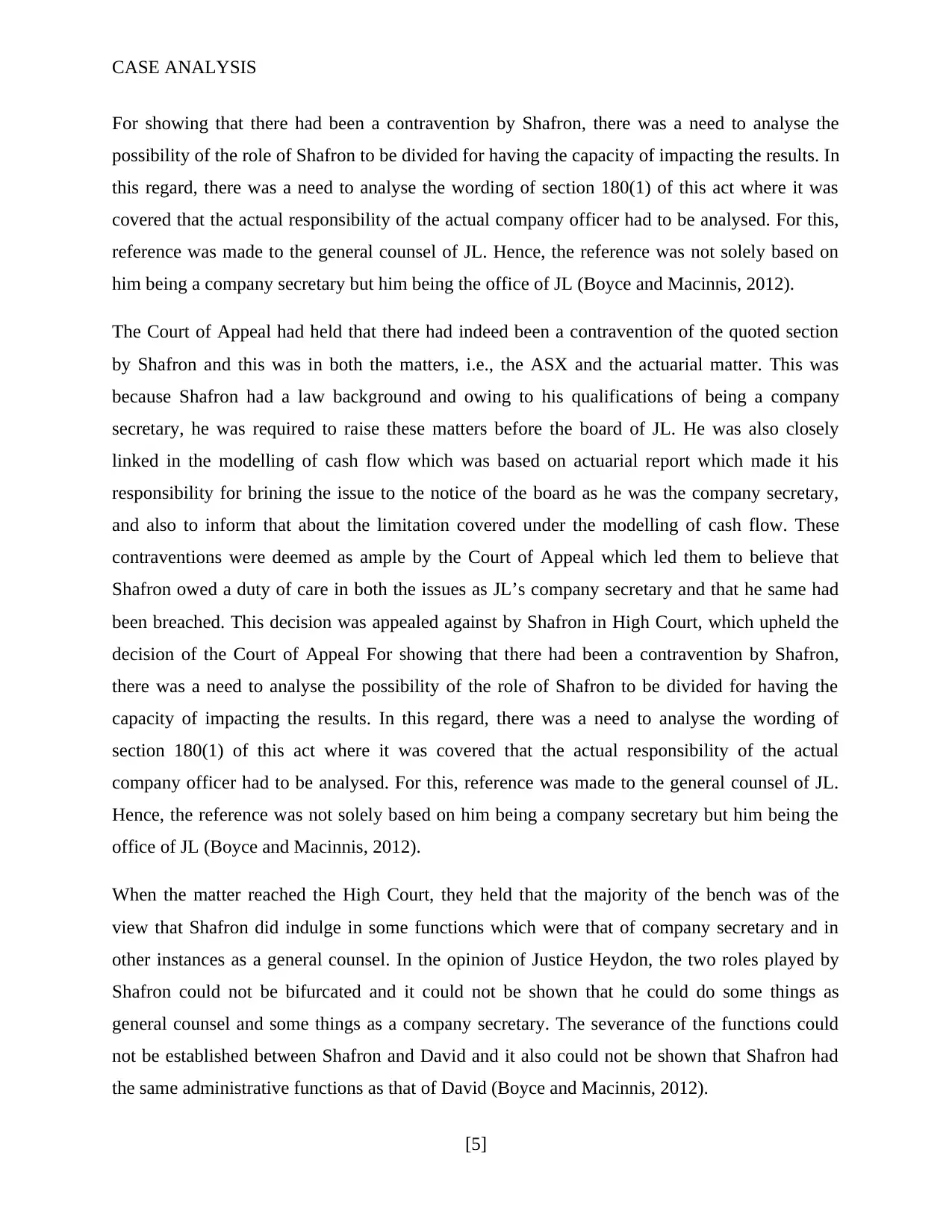
CASE ANALYSIS
For showing that there had been a contravention by Shafron, there was a need to analyse the
possibility of the role of Shafron to be divided for having the capacity of impacting the results. In
this regard, there was a need to analyse the wording of section 180(1) of this act where it was
covered that the actual responsibility of the actual company officer had to be analysed. For this,
reference was made to the general counsel of JL. Hence, the reference was not solely based on
him being a company secretary but him being the office of JL (Boyce and Macinnis, 2012).
The Court of Appeal had held that there had indeed been a contravention of the quoted section
by Shafron and this was in both the matters, i.e., the ASX and the actuarial matter. This was
because Shafron had a law background and owing to his qualifications of being a company
secretary, he was required to raise these matters before the board of JL. He was also closely
linked in the modelling of cash flow which was based on actuarial report which made it his
responsibility for brining the issue to the notice of the board as he was the company secretary,
and also to inform that about the limitation covered under the modelling of cash flow. These
contraventions were deemed as ample by the Court of Appeal which led them to believe that
Shafron owed a duty of care in both the issues as JL’s company secretary and that he same had
been breached. This decision was appealed against by Shafron in High Court, which upheld the
decision of the Court of Appeal For showing that there had been a contravention by Shafron,
there was a need to analyse the possibility of the role of Shafron to be divided for having the
capacity of impacting the results. In this regard, there was a need to analyse the wording of
section 180(1) of this act where it was covered that the actual responsibility of the actual
company officer had to be analysed. For this, reference was made to the general counsel of JL.
Hence, the reference was not solely based on him being a company secretary but him being the
office of JL (Boyce and Macinnis, 2012).
When the matter reached the High Court, they held that the majority of the bench was of the
view that Shafron did indulge in some functions which were that of company secretary and in
other instances as a general counsel. In the opinion of Justice Heydon, the two roles played by
Shafron could not be bifurcated and it could not be shown that he could do some things as
general counsel and some things as a company secretary. The severance of the functions could
not be established between Shafron and David and it also could not be shown that Shafron had
the same administrative functions as that of David (Boyce and Macinnis, 2012).
[5]
For showing that there had been a contravention by Shafron, there was a need to analyse the
possibility of the role of Shafron to be divided for having the capacity of impacting the results. In
this regard, there was a need to analyse the wording of section 180(1) of this act where it was
covered that the actual responsibility of the actual company officer had to be analysed. For this,
reference was made to the general counsel of JL. Hence, the reference was not solely based on
him being a company secretary but him being the office of JL (Boyce and Macinnis, 2012).
The Court of Appeal had held that there had indeed been a contravention of the quoted section
by Shafron and this was in both the matters, i.e., the ASX and the actuarial matter. This was
because Shafron had a law background and owing to his qualifications of being a company
secretary, he was required to raise these matters before the board of JL. He was also closely
linked in the modelling of cash flow which was based on actuarial report which made it his
responsibility for brining the issue to the notice of the board as he was the company secretary,
and also to inform that about the limitation covered under the modelling of cash flow. These
contraventions were deemed as ample by the Court of Appeal which led them to believe that
Shafron owed a duty of care in both the issues as JL’s company secretary and that he same had
been breached. This decision was appealed against by Shafron in High Court, which upheld the
decision of the Court of Appeal For showing that there had been a contravention by Shafron,
there was a need to analyse the possibility of the role of Shafron to be divided for having the
capacity of impacting the results. In this regard, there was a need to analyse the wording of
section 180(1) of this act where it was covered that the actual responsibility of the actual
company officer had to be analysed. For this, reference was made to the general counsel of JL.
Hence, the reference was not solely based on him being a company secretary but him being the
office of JL (Boyce and Macinnis, 2012).
When the matter reached the High Court, they held that the majority of the bench was of the
view that Shafron did indulge in some functions which were that of company secretary and in
other instances as a general counsel. In the opinion of Justice Heydon, the two roles played by
Shafron could not be bifurcated and it could not be shown that he could do some things as
general counsel and some things as a company secretary. The severance of the functions could
not be established between Shafron and David and it also could not be shown that Shafron had
the same administrative functions as that of David (Boyce and Macinnis, 2012).
[5]
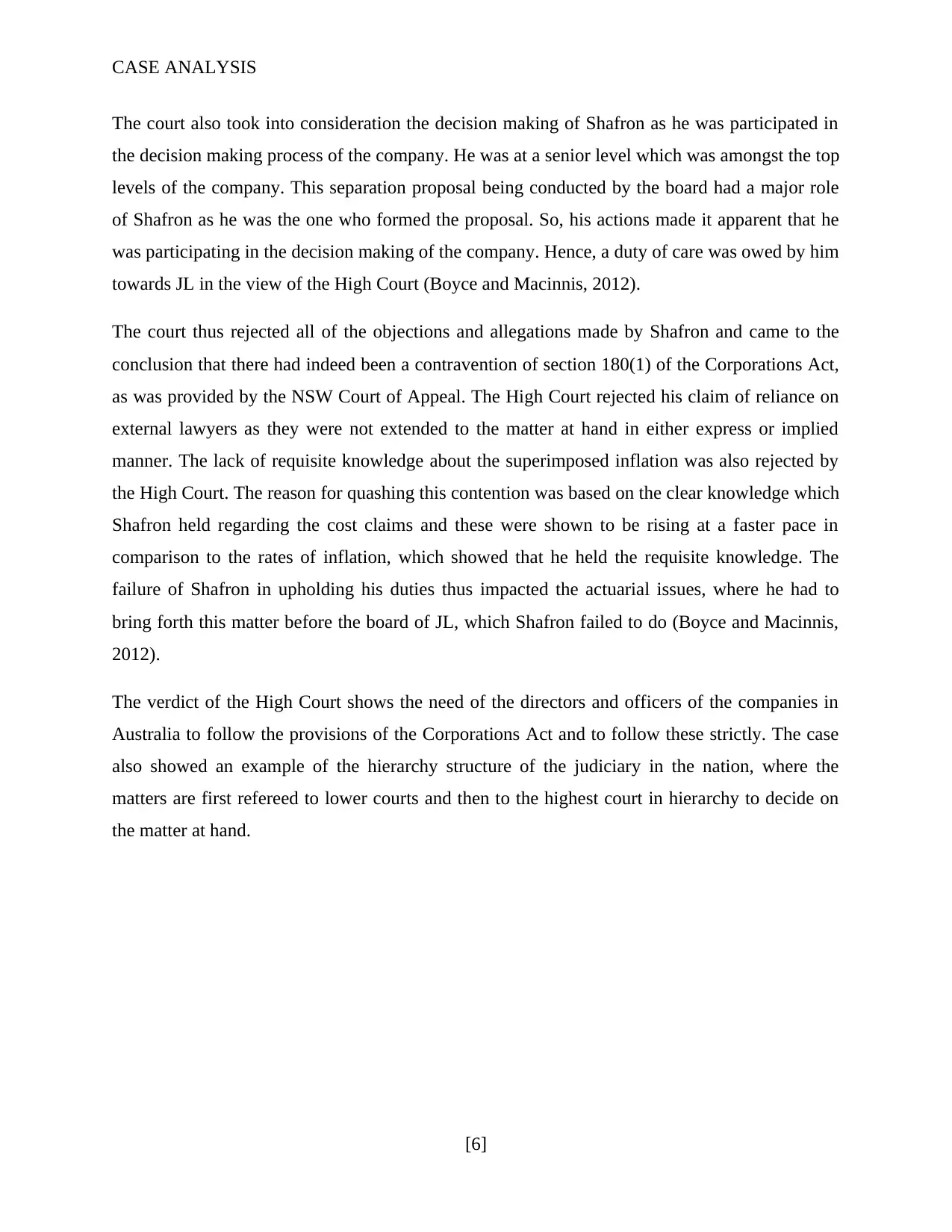
CASE ANALYSIS
The court also took into consideration the decision making of Shafron as he was participated in
the decision making process of the company. He was at a senior level which was amongst the top
levels of the company. This separation proposal being conducted by the board had a major role
of Shafron as he was the one who formed the proposal. So, his actions made it apparent that he
was participating in the decision making of the company. Hence, a duty of care was owed by him
towards JL in the view of the High Court (Boyce and Macinnis, 2012).
The court thus rejected all of the objections and allegations made by Shafron and came to the
conclusion that there had indeed been a contravention of section 180(1) of the Corporations Act,
as was provided by the NSW Court of Appeal. The High Court rejected his claim of reliance on
external lawyers as they were not extended to the matter at hand in either express or implied
manner. The lack of requisite knowledge about the superimposed inflation was also rejected by
the High Court. The reason for quashing this contention was based on the clear knowledge which
Shafron held regarding the cost claims and these were shown to be rising at a faster pace in
comparison to the rates of inflation, which showed that he held the requisite knowledge. The
failure of Shafron in upholding his duties thus impacted the actuarial issues, where he had to
bring forth this matter before the board of JL, which Shafron failed to do (Boyce and Macinnis,
2012).
The verdict of the High Court shows the need of the directors and officers of the companies in
Australia to follow the provisions of the Corporations Act and to follow these strictly. The case
also showed an example of the hierarchy structure of the judiciary in the nation, where the
matters are first refereed to lower courts and then to the highest court in hierarchy to decide on
the matter at hand.
[6]
The court also took into consideration the decision making of Shafron as he was participated in
the decision making process of the company. He was at a senior level which was amongst the top
levels of the company. This separation proposal being conducted by the board had a major role
of Shafron as he was the one who formed the proposal. So, his actions made it apparent that he
was participating in the decision making of the company. Hence, a duty of care was owed by him
towards JL in the view of the High Court (Boyce and Macinnis, 2012).
The court thus rejected all of the objections and allegations made by Shafron and came to the
conclusion that there had indeed been a contravention of section 180(1) of the Corporations Act,
as was provided by the NSW Court of Appeal. The High Court rejected his claim of reliance on
external lawyers as they were not extended to the matter at hand in either express or implied
manner. The lack of requisite knowledge about the superimposed inflation was also rejected by
the High Court. The reason for quashing this contention was based on the clear knowledge which
Shafron held regarding the cost claims and these were shown to be rising at a faster pace in
comparison to the rates of inflation, which showed that he held the requisite knowledge. The
failure of Shafron in upholding his duties thus impacted the actuarial issues, where he had to
bring forth this matter before the board of JL, which Shafron failed to do (Boyce and Macinnis,
2012).
The verdict of the High Court shows the need of the directors and officers of the companies in
Australia to follow the provisions of the Corporations Act and to follow these strictly. The case
also showed an example of the hierarchy structure of the judiciary in the nation, where the
matters are first refereed to lower courts and then to the highest court in hierarchy to decide on
the matter at hand.
[6]
⊘ This is a preview!⊘
Do you want full access?
Subscribe today to unlock all pages.

Trusted by 1+ million students worldwide
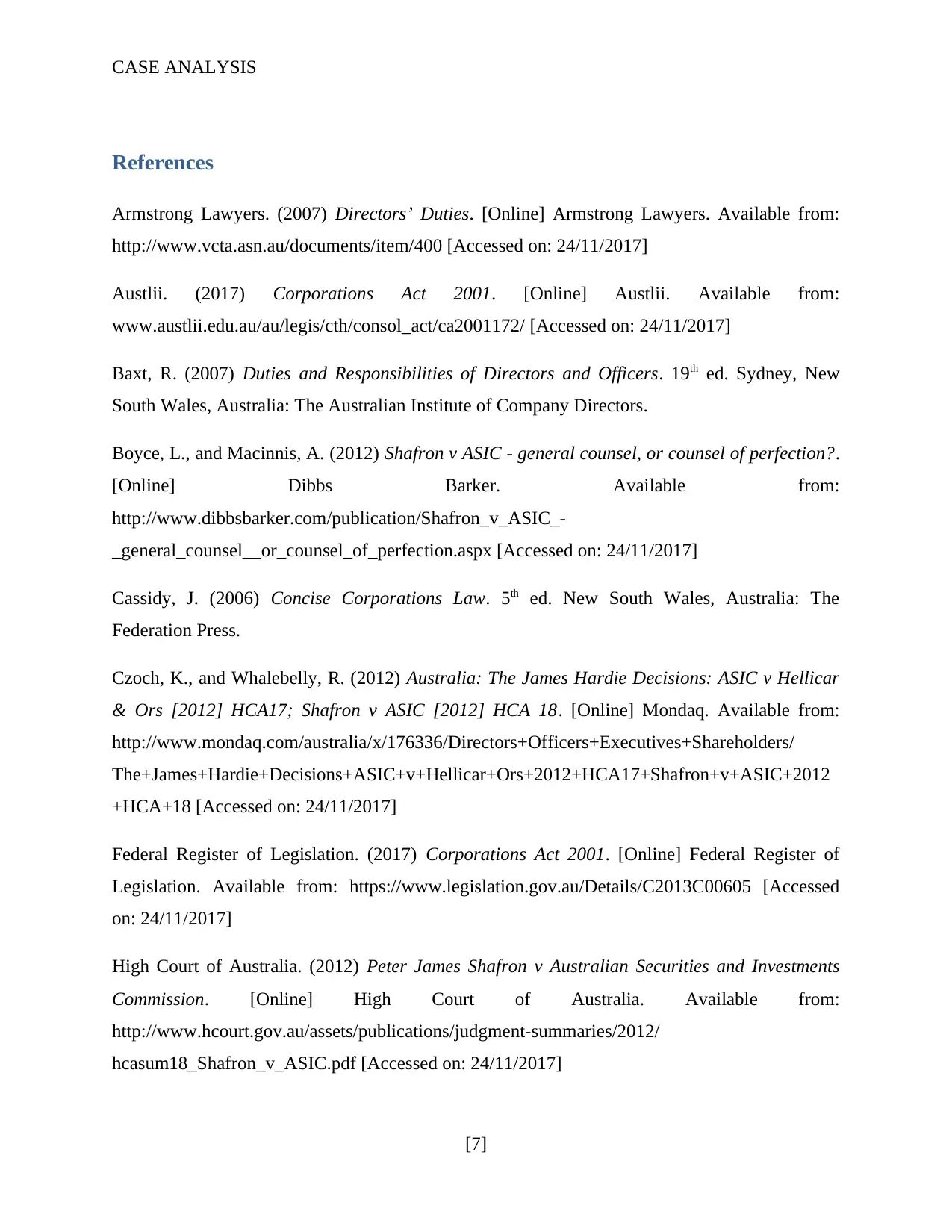
CASE ANALYSIS
References
Armstrong Lawyers. (2007) Directors’ Duties. [Online] Armstrong Lawyers. Available from:
http://www.vcta.asn.au/documents/item/400 [Accessed on: 24/11/2017]
Austlii. (2017) Corporations Act 2001. [Online] Austlii. Available from:
www.austlii.edu.au/au/legis/cth/consol_act/ca2001172/ [Accessed on: 24/11/2017]
Baxt, R. (2007) Duties and Responsibilities of Directors and Officers. 19th ed. Sydney, New
South Wales, Australia: The Australian Institute of Company Directors.
Boyce, L., and Macinnis, A. (2012) Shafron v ASIC - general counsel, or counsel of perfection?.
[Online] Dibbs Barker. Available from:
http://www.dibbsbarker.com/publication/Shafron_v_ASIC_-
_general_counsel__or_counsel_of_perfection.aspx [Accessed on: 24/11/2017]
Cassidy, J. (2006) Concise Corporations Law. 5th ed. New South Wales, Australia: The
Federation Press.
Czoch, K., and Whalebelly, R. (2012) Australia: The James Hardie Decisions: ASIC v Hellicar
& Ors [2012] HCA17; Shafron v ASIC [2012] HCA 18. [Online] Mondaq. Available from:
http://www.mondaq.com/australia/x/176336/Directors+Officers+Executives+Shareholders/
The+James+Hardie+Decisions+ASIC+v+Hellicar+Ors+2012+HCA17+Shafron+v+ASIC+2012
+HCA+18 [Accessed on: 24/11/2017]
Federal Register of Legislation. (2017) Corporations Act 2001. [Online] Federal Register of
Legislation. Available from: https://www.legislation.gov.au/Details/C2013C00605 [Accessed
on: 24/11/2017]
High Court of Australia. (2012) Peter James Shafron v Australian Securities and Investments
Commission. [Online] High Court of Australia. Available from:
http://www.hcourt.gov.au/assets/publications/judgment-summaries/2012/
hcasum18_Shafron_v_ASIC.pdf [Accessed on: 24/11/2017]
[7]
References
Armstrong Lawyers. (2007) Directors’ Duties. [Online] Armstrong Lawyers. Available from:
http://www.vcta.asn.au/documents/item/400 [Accessed on: 24/11/2017]
Austlii. (2017) Corporations Act 2001. [Online] Austlii. Available from:
www.austlii.edu.au/au/legis/cth/consol_act/ca2001172/ [Accessed on: 24/11/2017]
Baxt, R. (2007) Duties and Responsibilities of Directors and Officers. 19th ed. Sydney, New
South Wales, Australia: The Australian Institute of Company Directors.
Boyce, L., and Macinnis, A. (2012) Shafron v ASIC - general counsel, or counsel of perfection?.
[Online] Dibbs Barker. Available from:
http://www.dibbsbarker.com/publication/Shafron_v_ASIC_-
_general_counsel__or_counsel_of_perfection.aspx [Accessed on: 24/11/2017]
Cassidy, J. (2006) Concise Corporations Law. 5th ed. New South Wales, Australia: The
Federation Press.
Czoch, K., and Whalebelly, R. (2012) Australia: The James Hardie Decisions: ASIC v Hellicar
& Ors [2012] HCA17; Shafron v ASIC [2012] HCA 18. [Online] Mondaq. Available from:
http://www.mondaq.com/australia/x/176336/Directors+Officers+Executives+Shareholders/
The+James+Hardie+Decisions+ASIC+v+Hellicar+Ors+2012+HCA17+Shafron+v+ASIC+2012
+HCA+18 [Accessed on: 24/11/2017]
Federal Register of Legislation. (2017) Corporations Act 2001. [Online] Federal Register of
Legislation. Available from: https://www.legislation.gov.au/Details/C2013C00605 [Accessed
on: 24/11/2017]
High Court of Australia. (2012) Peter James Shafron v Australian Securities and Investments
Commission. [Online] High Court of Australia. Available from:
http://www.hcourt.gov.au/assets/publications/judgment-summaries/2012/
hcasum18_Shafron_v_ASIC.pdf [Accessed on: 24/11/2017]
[7]
Paraphrase This Document
Need a fresh take? Get an instant paraphrase of this document with our AI Paraphraser
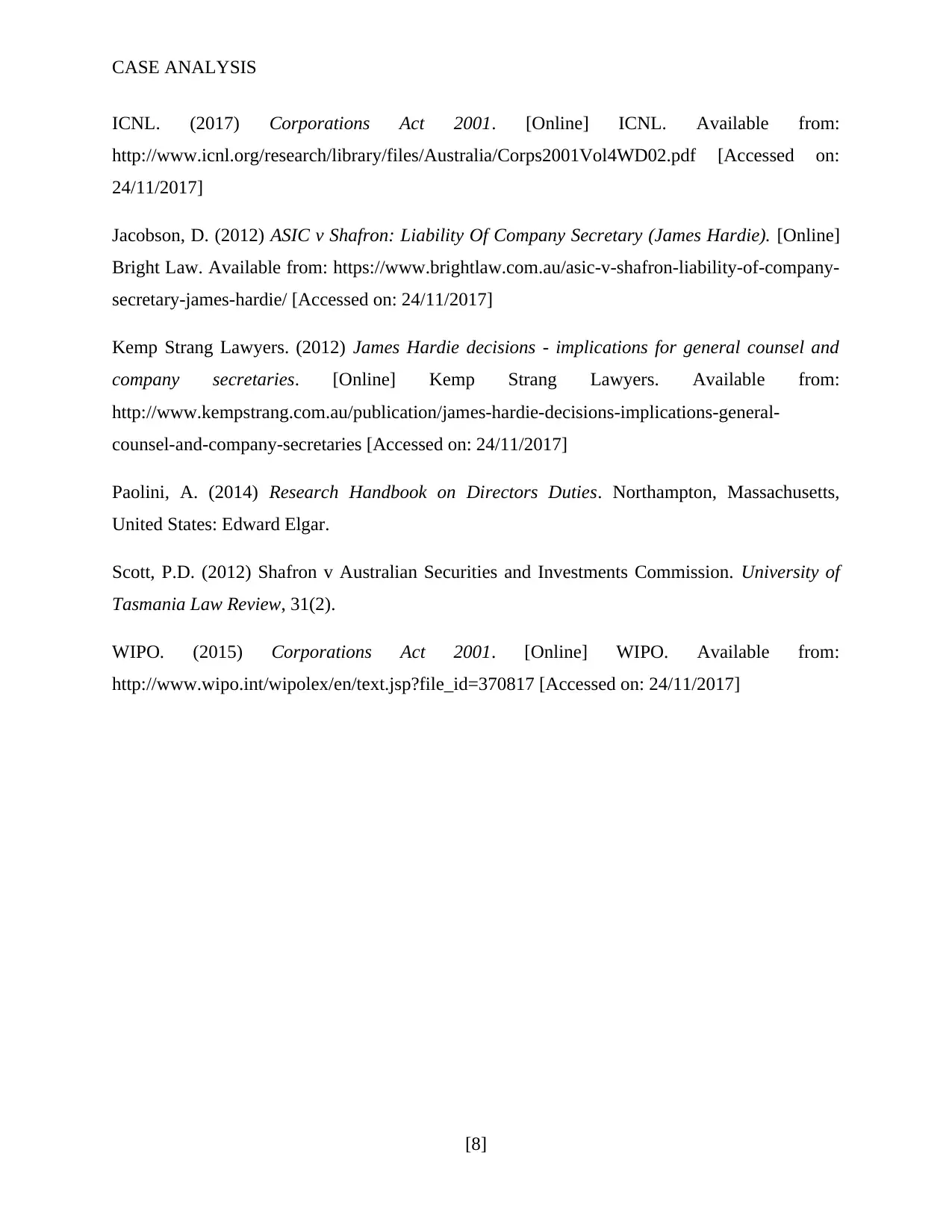
CASE ANALYSIS
ICNL. (2017) Corporations Act 2001. [Online] ICNL. Available from:
http://www.icnl.org/research/library/files/Australia/Corps2001Vol4WD02.pdf [Accessed on:
24/11/2017]
Jacobson, D. (2012) ASIC v Shafron: Liability Of Company Secretary (James Hardie). [Online]
Bright Law. Available from: https://www.brightlaw.com.au/asic-v-shafron-liability-of-company-
secretary-james-hardie/ [Accessed on: 24/11/2017]
Kemp Strang Lawyers. (2012) James Hardie decisions - implications for general counsel and
company secretaries. [Online] Kemp Strang Lawyers. Available from:
http://www.kempstrang.com.au/publication/james-hardie-decisions-implications-general-
counsel-and-company-secretaries [Accessed on: 24/11/2017]
Paolini, A. (2014) Research Handbook on Directors Duties. Northampton, Massachusetts,
United States: Edward Elgar.
Scott, P.D. (2012) Shafron v Australian Securities and Investments Commission. University of
Tasmania Law Review, 31(2).
WIPO. (2015) Corporations Act 2001. [Online] WIPO. Available from:
http://www.wipo.int/wipolex/en/text.jsp?file_id=370817 [Accessed on: 24/11/2017]
[8]
ICNL. (2017) Corporations Act 2001. [Online] ICNL. Available from:
http://www.icnl.org/research/library/files/Australia/Corps2001Vol4WD02.pdf [Accessed on:
24/11/2017]
Jacobson, D. (2012) ASIC v Shafron: Liability Of Company Secretary (James Hardie). [Online]
Bright Law. Available from: https://www.brightlaw.com.au/asic-v-shafron-liability-of-company-
secretary-james-hardie/ [Accessed on: 24/11/2017]
Kemp Strang Lawyers. (2012) James Hardie decisions - implications for general counsel and
company secretaries. [Online] Kemp Strang Lawyers. Available from:
http://www.kempstrang.com.au/publication/james-hardie-decisions-implications-general-
counsel-and-company-secretaries [Accessed on: 24/11/2017]
Paolini, A. (2014) Research Handbook on Directors Duties. Northampton, Massachusetts,
United States: Edward Elgar.
Scott, P.D. (2012) Shafron v Australian Securities and Investments Commission. University of
Tasmania Law Review, 31(2).
WIPO. (2015) Corporations Act 2001. [Online] WIPO. Available from:
http://www.wipo.int/wipolex/en/text.jsp?file_id=370817 [Accessed on: 24/11/2017]
[8]
1 out of 8
Related Documents
Your All-in-One AI-Powered Toolkit for Academic Success.
+13062052269
info@desklib.com
Available 24*7 on WhatsApp / Email
![[object Object]](/_next/static/media/star-bottom.7253800d.svg)
Unlock your academic potential
Copyright © 2020–2025 A2Z Services. All Rights Reserved. Developed and managed by ZUCOL.

![Case Study Analysis: Shafron v ASIC [2012] HCA 18 and Corporate Law](/_next/image/?url=https%3A%2F%2Fdesklib.com%2Fmedia%2Fimages%2Fen%2Fcbcdf6d2236f4eae97476bcab5958c46.jpg&w=256&q=75)



